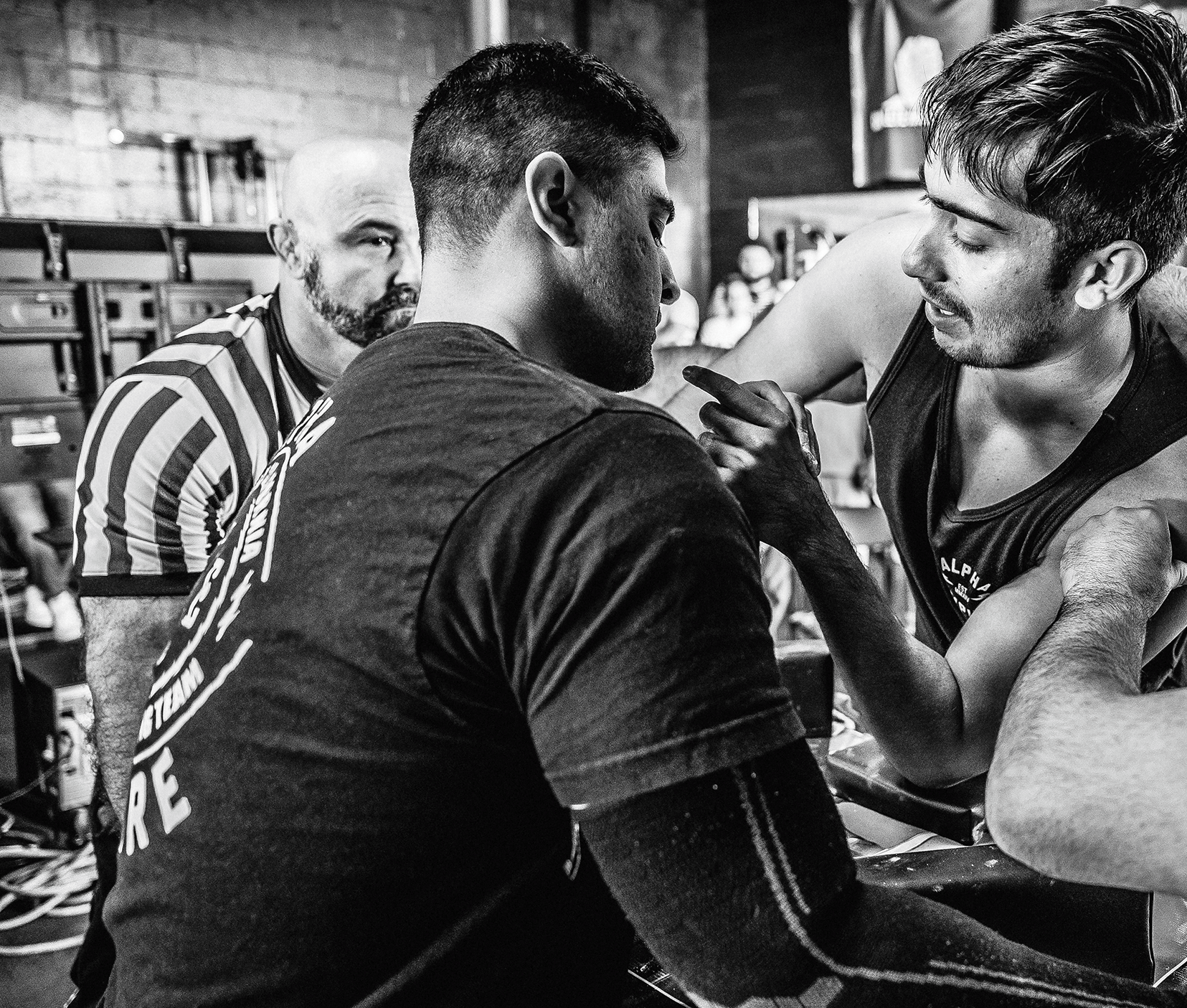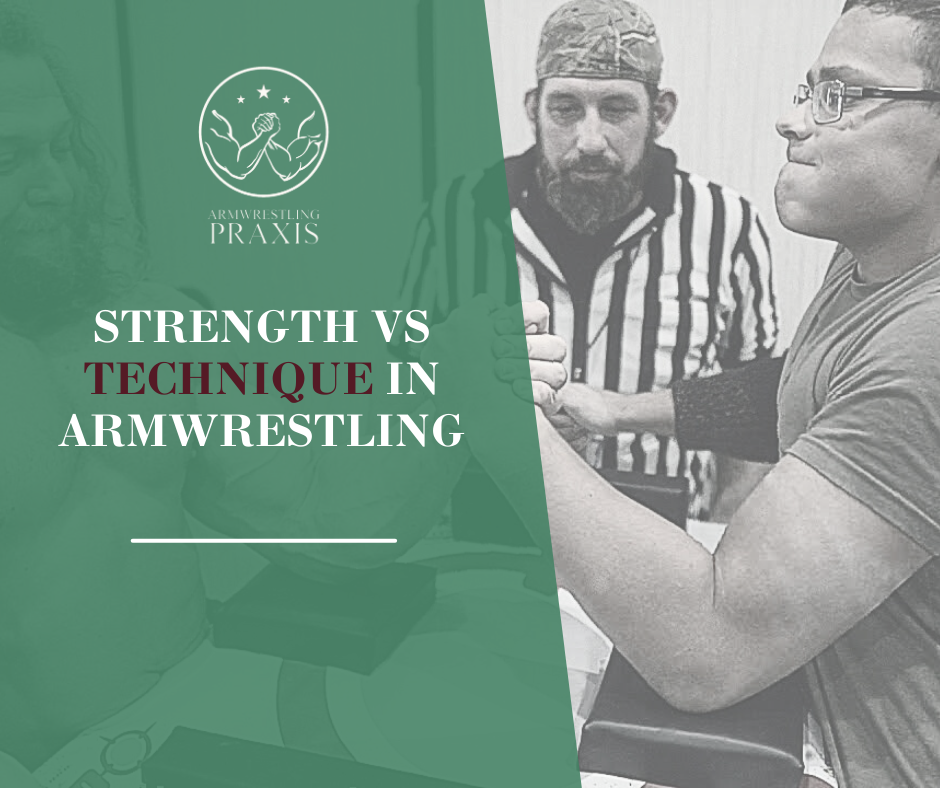In this article we’ll explore the uniquely persistent question of how strength and technique are relevant to armwrestling and which one, if either, is more important for beating the person across from us.
Before we get ahead of ourselves, it’s worth reviewing the strength vs. technique debate from the general population’s perspective:
When opining on the matter, it seems that casual folks lean towards technique rather than strength being the primary driver for securing victory, especially when commenting on popular videos where smaller, seemingly-weaker pro armwrestlers are toying with larger, more muscular amateur opponents.
Strength is important, they say, but it’s the armwrestler’s application of some specialized technique – and their opponent’s ignorance of said techniques and counters – that gives them the biggest advantage rather than pure strength.
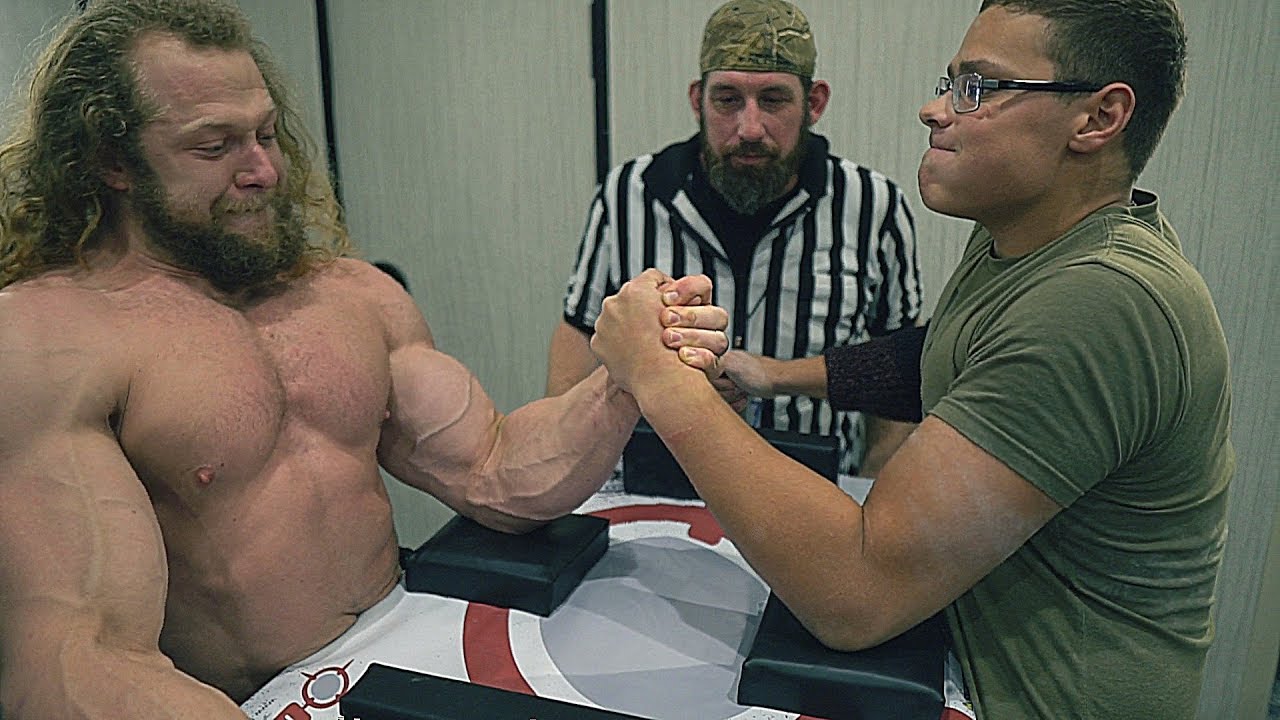 YouTuber Jujimufu (Left) vs. pro armwrestler Aleksandr “Schoolboy” Beziazykov (Right)
YouTuber Jujimufu (Left) vs. pro armwrestler Aleksandr “Schoolboy” Beziazykov (Right)
While many of these answers do have elements of truth in them, they’re usually presented in a kind of specious or anecdotal manner and lead to more questions springing up rather than closure on the matter.
In the spirit of inquiry then, let’s investigate exactly how strength and technique come into play in an armwrestling match by running through some thought experiments and see if we can extract some useful answers in the process.
This post will be a longer, more involved read, but at the end of it you’ll have a much better perspective on how to approach the “strength vs. technique” debate.
Before we begin, I want to present basic definitions for each term so we can all be on the same page on what it is we’re actually referring to when we say “strength” and “technique”:
Technique: A skillful or efficient way of doing or achieving something.1
Strength: The measure of force produced on physical objects (whether maximal or sub-maximal in the case of the human body).
Okay. Armed with these definitions let’s dive into the following scenario.
Scenario 1: Non-Armwrestler vs. Non-Armwrestler
Let’s imagine that we have two healthy individuals gripping up for an armwrestle and assume that both are of similar strength levels and have zero technical knowledge about armwrestling; we’ll call them Mr. N and Mr. B.
Let’s further assume that both participants start fairly, which just means that neither have any major mechanical advantages in their starting positions nor are they exerting significant pressures into their opponent’s hand beyond a standard grip.
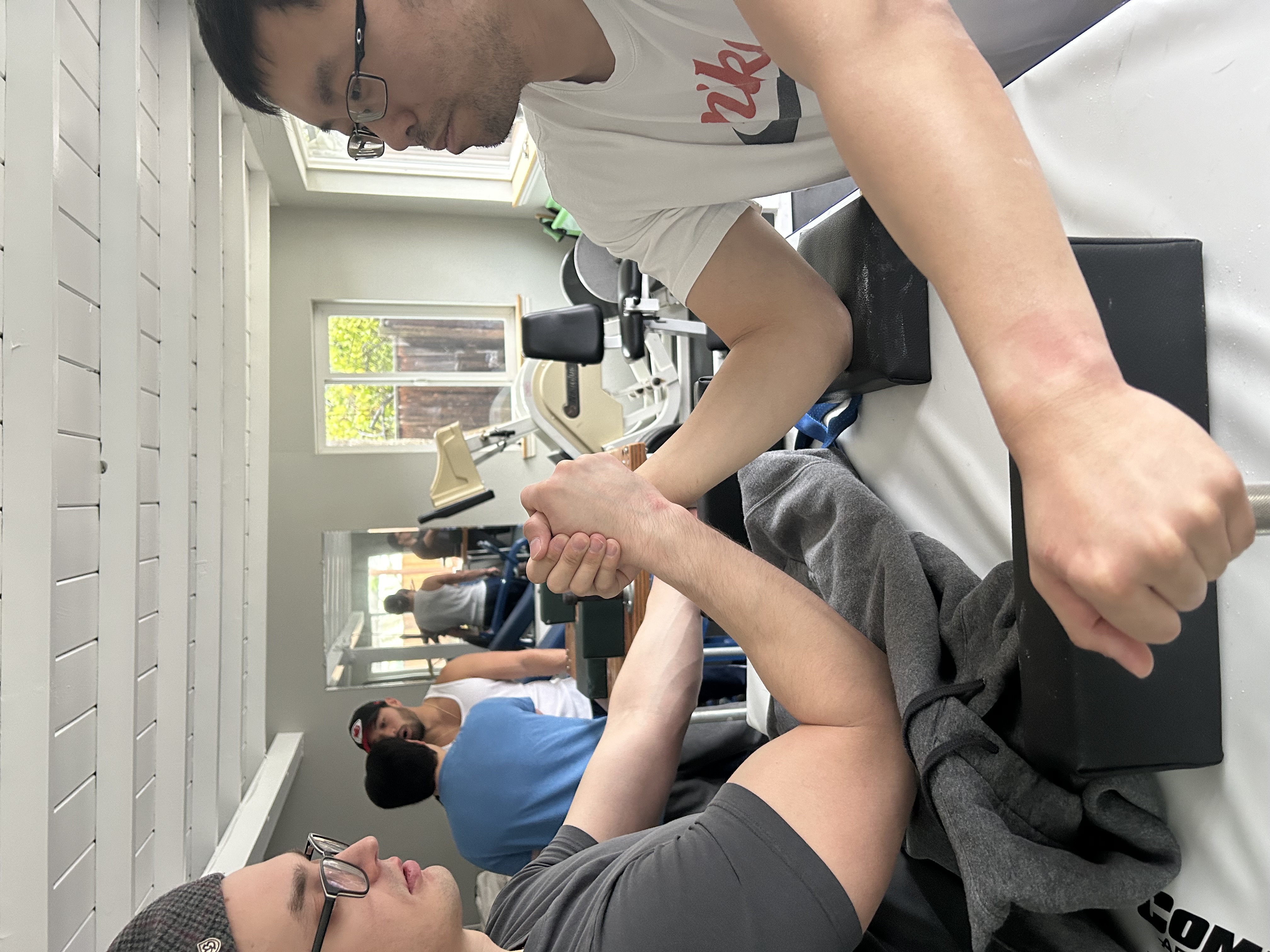 Mr. N (Left) vs. Mr. B (Right)
Mr. N (Left) vs. Mr. B (Right)
What happens here?
Well usually at the start of the match both participants begin to “push” sideways (a terrible way to armwrestle, btw) in order to pin their opponent’s hand and we observe that things can go one way or the other since both are capable of producing similar levels of force and don’t have any technique to fall back on.
Maybe out of 10 hypothetical matches we have a rough 50 % win rate for either person, so at this point we don’t have a clear answer for whether strength or technique are more important.
Suppose now Mr. N turns to his pro armwrestler friend for advice on how to gain an advantage over the equally-strong Mr. B and is told exactly how to do so through the application of some technique.
Now if we replay the scenario it’s very likely that Mr. N will consistently beat Mr. B (assuming the latter doesn’t make any significant adjustments of his own), and, as a result, we can award “technique” as the more important factor for victory in this particular case.
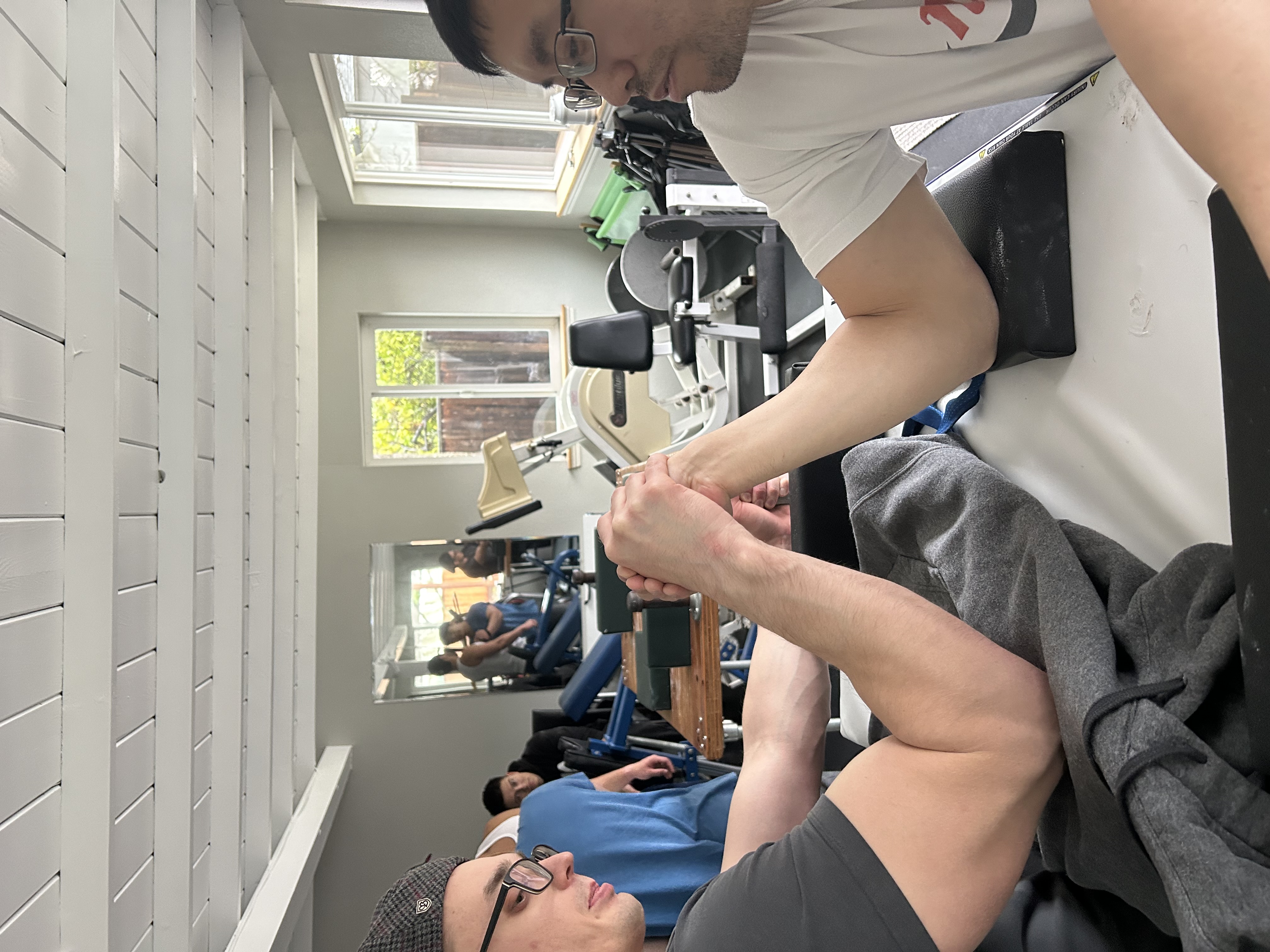 Mr. N exploiting the fingers and wrist of Mr. B
Mr. N exploiting the fingers and wrist of Mr. B
Observing this result, we can clearly understand why most casual folks rate technique so highly since the person applying it can consistently gain advantages over another. Add to all of this the fact that one can potentially even beat stronger opponents with technique alone and the “technique > strength” perspective starts looking like the clear winner of the debate.
To summarize then, for most non-armwrestlers (basically the general population writ large) who aren’t pulling someone far stronger than them, technique or “a more efficient way of achieving advantages/pinning one’s opponent” will usually result in beating other non-armwrestlers who are unaware of how to counter or apply techniques in response.
Since this scenario accounts for the vast majority of human beings who have armwrestled – and since many of these people are observant enough to recognize that a specialized technique can make a big difference in the outcome of a match – they assume that technique (and not strength) is the decisive factor in armwrestling, even in cases where a professional armwrestler is beating a seemingly “stronger” opponent.
Let’s see why this is a flawed argument using the next scenario.
Scenario 2: Armwrestler vs. Non-Armwrestler
Alright, for this second scenario we’ll be using the following video in which pro strongman Brian Shaw is being coached by pro armwrestler Derek Smith on the fundamentals of the sport:
Now if you aren’t aware, Brian Shaw is an ultra-elite strongman competitor who has some of the most noteworthy achievements in the sport and is very much in the argument for one of the strongest men who have ever lived.
While Derek is a top-level armwrestler and a strong individual in his own right, he doesn’t have the same conventional strength capabilities as Brian and so we can assume that this is a case of a “stronger” non-armwrestler going up against a “weaker” armwrestler.
For most of the video Derek is coaching Brian on the fundamentals of how to move on an armmwrestling table as well as how to apply specific pressures and strategies during a match, however, there are a few moments when Brian tries to exert himself and overpower Derek’s pressures and is unable to do so even when the latter deliberately places himself in a compromised position.
Thus, it becomes clear by the end of the video that Derek could easily best Brian in a real armwrestling match, and frankly, no one is too surprised by this.

BUT, if I pose the question of whether strength or technique is what primarily enables Derek to do all of this, most casual folks would confidently assert “technique” since Brian is clearly the stronger of the two.
I’m going to argue for the opposite case: that although a degree of technique is certainly involved in gaining an advantage, the decisive factor for why Derek (and other professional armwrestlers) toy with most amateurs is strength.
To support my argument I’ll assert and expand on the following two points:
-
Our body’s ability to produce force in an armwrestling match (strength) is ALWAYS required whenever we are trying to “overcome” the physical resistance applied by our opponent.
-
Any technique that’s incorporated towards overcoming this resistance achieves two broad goals:
-
It effectively “lowers” the strength required to overcome resistance.
-
It increases the possibilities for exploiting an opponent’s weaknesses and for maximizing one’s own ability to produce strength.
Let’s examine each of these points more closely.
A Strength Analogy
To break down the idea behind the first goal of technique – a “lowering of the strength requirement for overcoming resistance” – let’s use the following scenario from the traditional strength world:
Let’s say you’re a noob at the gym attempting to deadlift a certain amount of weight and have never done the movement before.
You make your first attempt, exert maximum effort in trying to get it off the floor, almost blow out your back and…..it doesn’t budge.

Observing your attempt, a seasoned lifter comes over to you and says, “Why don’t you try setting your feet closer to the bar, and engaging your lats, and straightening your lower back…?” and all of the other efficient ways we can utilize our body to execute the movement.
In other words: all of the techniques we can apply to lift this weight off the floor.
You follow all of those instructions to the letter, all of those skillful and efficient ways to achieve the outcome of lifting this weight and…..
It doesn’t budge.
What happened here?
Well, simply put: you weren’t strong enough. In both cases.
Your body was unable to produce enough force against a specific kind of physical resistance in order to achieve “movement” regardless of the efficient adjustments it was making.
To put things more clearly:
All that the application of a particular set of techniques did is allow one to effectively lower the strength required to achieve the same outcome.
 When applied towards overcoming resistance, technique allows us to “do more with less.”
When applied towards overcoming resistance, technique allows us to “do more with less.”
So in our example above, if you’re trying to deadlift 400 lbs like a caveman and fail and then end up using all of the proper techniques listed, what you’re effectively doing is turning that 400 lbs into 350 lbs by recruiting the proper muscles, placing yourself in a mechanically advantageous position, pulling the slack out of the bar etc.2
But here’s the important point: you still have to be strong enough to deadlift 350!
Armwrestling is a (Mostly) Strength-Sport
Coming back to armwrestling, the same logic applies.
A large portion of the techniques that professional armwrestlers implement are simply efficient ways of lowering the strength requirements of achieving a particular outcome. Whether that outcome is exploiting their opponent’s hand and wrist, executing a positional adjustment or transition, or just trying to pin, the application of their techniques lets them get away with “lifting 350” instead of the whole 400.
This is why I asserted that strength is, ultimately, a more important factor than technique for armwrestler vs non-armwrestler scenarios since it is strength which bounds and defines the conditions of success of a particular kind of technique.
Essentially, if the armwrestler doesn’t meet that minimum strength requirement of being able to overcome any kind of resistance from their opponent, then technique achieves nothing.
Now, the reality of armwrestling is more complex than lifting static weights. When we grip up with our opponent, it’s almost as if we are trying to lift a weight that’s capable of varying the direction and magnitude of the resistance it produces as well as applying techniques of its own to deliberately make things harder for us.
This is why armwrestling is most commonly viewed as a strength AND combat sport and the combat side of things is where the second goal of technique that I listed above comes into play:
Technique increases the possibilities for exploiting an opponent’s weaknesses and for maximizing one’s own ability to produce strength.
So much of competitive armwrestling is about achieving exactly this goal.
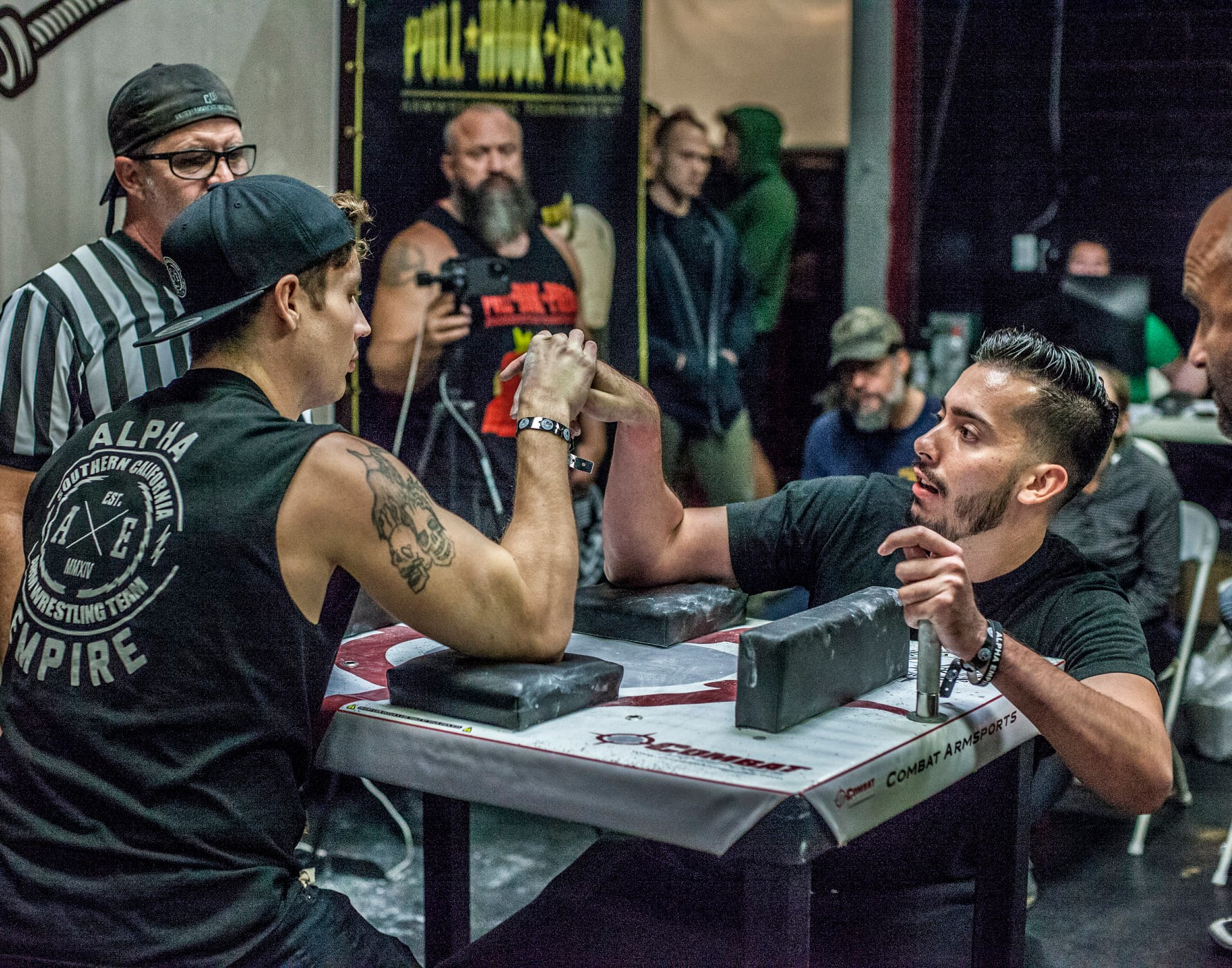 Photo by Ed Bedrosian.
Photo by Ed Bedrosian.
We want to apply our pressures and movements in such a way so as to nullify our opponent’s strength, while simultaneously unlocking our own. This is the other function of technique which allows armwrestlers the ability to side-step a loss from slightly stronger opponents and is very much worth the effort to improve and develop during training.
But, once again, if you’re only strong enough to lift 50 lbs those techniques don’t matter much (if at all) against a stronger opponent who’s applying 80 lbs of resistance, and you simply have to get stronger in armwrestling-specific movements in order to “unlock” the ability to use those techniques.
Still paying attention? We’re almost done, but the final piece I want to talk about is the “armwrestling-specific movements” idea from the sentence above.
Armwrestling-Specific Strength
What we have to understand about the idea of strength (as it pertains to the human body and its various systems) is that it’s a much more “particular” ability than most people recognize.
To use a familiar example, when most people see bodybuilders they intuitively understand that although they have large amounts of muscle mass, they might not be as strong as, say, a powerlifter in conventional strength movements like the bench press, squat, and deadlift since the powerlifter trains and develops the specific factors that are involved in maximizing their ability to improve performance in these specific movements.
This principle of specificity carries over to a sport like armwrestling where those same bodybuilders and powerlifters are unable to resist/produce the forces exerted by an armwrestler simply due to their lack of development in the required specific areas of strength.
This, I believe, is the source of so much confusion that arises in the strength vs. technique debate. Not only is there a misunderstanding of what technique is actually doing, but the whole notion of “strength” omits the principle of specificity so that most casual folks hardly recognize that armwrestling prioritizes the ability to produce force in a very particular rather than conventional way.3
 Armwrestling is a strength-specific sport above all. Artarm handle featured
Armwrestling is a strength-specific sport above all. Artarm handle featured
I’ve kept you all in suspense for too long and so, if you didn’t already know, the specific areas of strength that are most important for armwrestling are the hand, wrist, and forearm.
Although the rest of the upper body can (and should) be recruited to aid in producing maximal force in an armwrestling match, it all has to ultimately come through the hand and wrist since it is this part of the body which receives the force (from our opponent’s hand) and which force must be applied through in order to properly counter and control our opponent’s strengths.
This is the reason why professional armwrestlers like Derek are able to easily beat seemingly “stronger” amateurs like Brian: they have developed armwrestling specific-strengths to a much higher degree than amateurs in addition to applying efficient techniques in order to maximize their chances of victory.
For a more detailed look at the specific hand/wrist motions involved in armwrestling check out this article.
The Full Picture
So what have we learned?
Well, we know that strength AND technique are both necessary for winning an armwrestling match and that the answer to the question of which is more important will depend on who the participants are.
For those who are casual armwrestlers and are just looking to beat some of their buddies of a similar strength level, it certainly helps to learn a bit of technique so that you can “get away” with exerting less strength and/or exploiting their weaknesses, but in those cases for when your opponent is notably stronger than you, you’ll simply have to develop those armwrestling specific-strengths in order to level things out.
For those situations where pro armwrestlers are dominating larger, conventionally stronger opponents, strength is the decisive factor for why the armwrestler is able to do what they do, while technique simply affords them the ability to reduce the load and expose weaknesses.
Hopefully this article has cleared things up for you a bit and piqued your curiosity enough to learn more about the details of armwrestling-specific strengths and technique.
You can find more on both of those here:
Notes
- For a sport like armwrestling this can encompass the whole spectrum of moves, tactics, and adjustments that are used to help us pin our opponent’s hand
- For all the pedants who find fault in my definition for technique, I’m well aware that we can’t use technique to change the actual resistance produced by a static load and that 400lbs is always 400 lbs. I’m simply saying that the application of technique makes it feel as though we’ve lightened the load and, as a result, have primed our bodies to more efficiently overcome it.
- Here “conventional” just means a person’s ability to generate force in traditional strength movements such as the bench press, overhead press, squat, deadlift, bicep curl and so many others which are certainly important in their own right, but do not supersede the specific areas of strength which are required for effective armwrestling.
